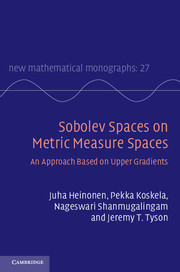Book contents
- Frontmatter
- Dedication
- Contents
- Preface
- 1 Introduction
- 2 Review of basic functional analysis
- 3 Lebesgue theory of Banach space-valued functions
- 4 Lipschitz functions and embeddings
- 5 Path integrals and modulus
- 6 Upper gradients
- 7 Sobolev spaces
- 8 Poincaré inequalities
- 9 Consequences of Poincaré inequalities
- 10 Other definitions of Sobolev-type spaces
- 11 Gromov–Hausdorff convergence and Poincaré inequalities
- 12 Self-improvement of Poincaré inequalities
- 13 An introduction to Cheeger's differentiation theory
- 14 Examples, applications, and further research directions
- References
- Notation index
- Subject index
4 - Lipschitz functions and embeddings
Published online by Cambridge University Press: 05 February 2015
- Frontmatter
- Dedication
- Contents
- Preface
- 1 Introduction
- 2 Review of basic functional analysis
- 3 Lebesgue theory of Banach space-valued functions
- 4 Lipschitz functions and embeddings
- 5 Path integrals and modulus
- 6 Upper gradients
- 7 Sobolev spaces
- 8 Poincaré inequalities
- 9 Consequences of Poincaré inequalities
- 10 Other definitions of Sobolev-type spaces
- 11 Gromov–Hausdorff convergence and Poincaré inequalities
- 12 Self-improvement of Poincaré inequalities
- 13 An introduction to Cheeger's differentiation theory
- 14 Examples, applications, and further research directions
- References
- Notation index
- Subject index
Summary
In this chapter, we gather further miscellaneous basic results that will be used in later chapters. We discuss Lipschitz functions, extension and embedding theorems, Hausdorff measures, lower semicontinuous functions, and functions of bounded variation with values in an arbitrary metric space.
Lipschitz functions, extensions, and embeddings
A function f : X → Y from a metric space X = (X, dX) to a metric space Y = (Y, dY) is said to be L-Lipschitz if there exists a constant L ≥ 0 such that
dY(f(a), f(b)) ≤ LdX(a, b)
for each pair of points a, b ∈ X. We also say that a function is Lipschitz if it is L-Lipschitz for some L. The smallest L such that (4.1.1) holds for each pair of points a, b ∈ X is called the Lipschitz constant of f.
If f : X → Y is a Lipschitz bijection whose inverse is also Lipschitz, we say that f is a bilipschitz map between X and Y and that X and Y are bilipschitz equivalent. The term L-bilipschitz is self-explanatory. A 1-bilipschitz map is an isometry. Two metric spaces are isometric if there is an isometry between them. We also say that X admits a bilipschitz embedding into Y if there is a bilipschitz embedding of X into Y. Recall that an embedding is a map that is a homeomorphism onto its image; this concept was used earlier, in Section 3.3. A 1-bilipschitz embedding is called an isometric embedding. If X admits an isometric embedding into Y, we often suppress the embedding from the notation and write X ⊂ Y.
We say that a function f : X → Y is locally Lipschitz if every point in X has a neighborhood such that the restriction of f to this neighborhood is Lipschitz. The term locally L-Lipschitz means that these restrictions are L-Lipschitz.
Lipschitz functions play a central role in the theory of Sobolev spaces as developed in this book. In particular, in general spaces Lipschitz functions constitute an important substitute for smooth functions. We will prove, for example, that in many interesting cases locally Lipschitz functions are dense in a Sobolev space. To this end, in the present chapter we will study the density of Lipschitz functions in other situations.
- Type
- Chapter
- Information
- Sobolev Spaces on Metric Measure SpacesAn Approach Based on Upper Gradients, pp. 98 - 120Publisher: Cambridge University PressPrint publication year: 2015



